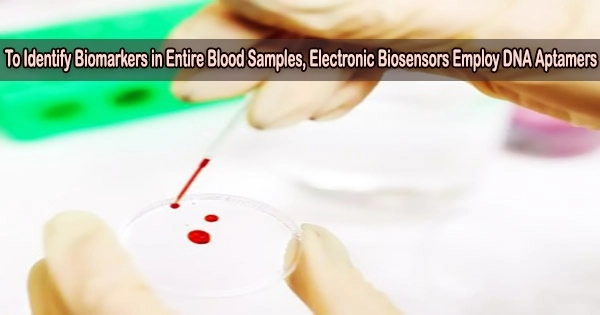An electronic biosensor based on DNA aptamers has been created by a research team that can identify biomarkers in entire blood samples without the need of chemicals. The DNA aptamers identify marker proteins as effectively as antibodies do, but they are simpler to manufacture and more versatile, according to the team’s explanation in the journal Angewandte Chemie International Edition.
Without any additional sample preparation, the biosensor was able to identify clinically significant quantities of a protein that serves as a marker for cardiovascular disease.
The goal of research is to create diagnostic systems that can accurately and directly identify disease biomarkers in the field, without the need to transfer samples to specialist labs for processing.
Shana O. Kelley of the University of Toronto, Canada, and Northwestern University in Evanston, IL, U.S., and her team have developed a simple chip-based device to detect marker proteins in complex samples using chronoamperometric measurements.
Their nanoscale sensor system works as a molecular “pendulum”: it measures the extra load a protein places on the pendulum, which consists of a strand of DNA tethered to an electrode. The approach does not require any external reagents.
DNA has the most predictable and programmable interactions of any natural or synthetic molecule.
Shana O. Kelley and her team
Typically, marker proteins are searched for and bound by antibodies in complex mixtures. However, as antibodies are proteins in and of themselves, they are exceedingly difficult to make and design.
Now, Kelley and colleagues have discovered that DNA aptamers, which are smaller and easier to utilize, can be employed in place of antibodies.
DNA aptamers are short synthetic fragments of with specific shapes and structures. Because of their adaptable architectures, they are more affordable to generate than antibodies and relatively simple to make.
DNA aptamers can bind marker proteins through molecular and structural interactions, just like antibodies, but they are simpler to create.
“DNA has the most predictable and programmable interactions of any natural or synthetic molecule,” explain Kelley and her team.
To develop an aptamer-based sensor, they created a DNA aptamer that specifically detects B-type natriuretic peptide (BNP), a biomarker for cardiovascular disease, and linked this aptamer with the DNA pendulum strand tethered to the gold electrode to create the molecular pendulum sensor.
Even in complicated mixes like whole blood from cardiac patients that hadn’t been treated, the finished biosensor was able to detect BNP. As a result of Kelley and colleagues’ discovery that the aptamer-based system’s sensitivity was comparable to that of antibody-based detection, they advise further study and application of DNA aptamers for laboratory-independent diagnostics.
















